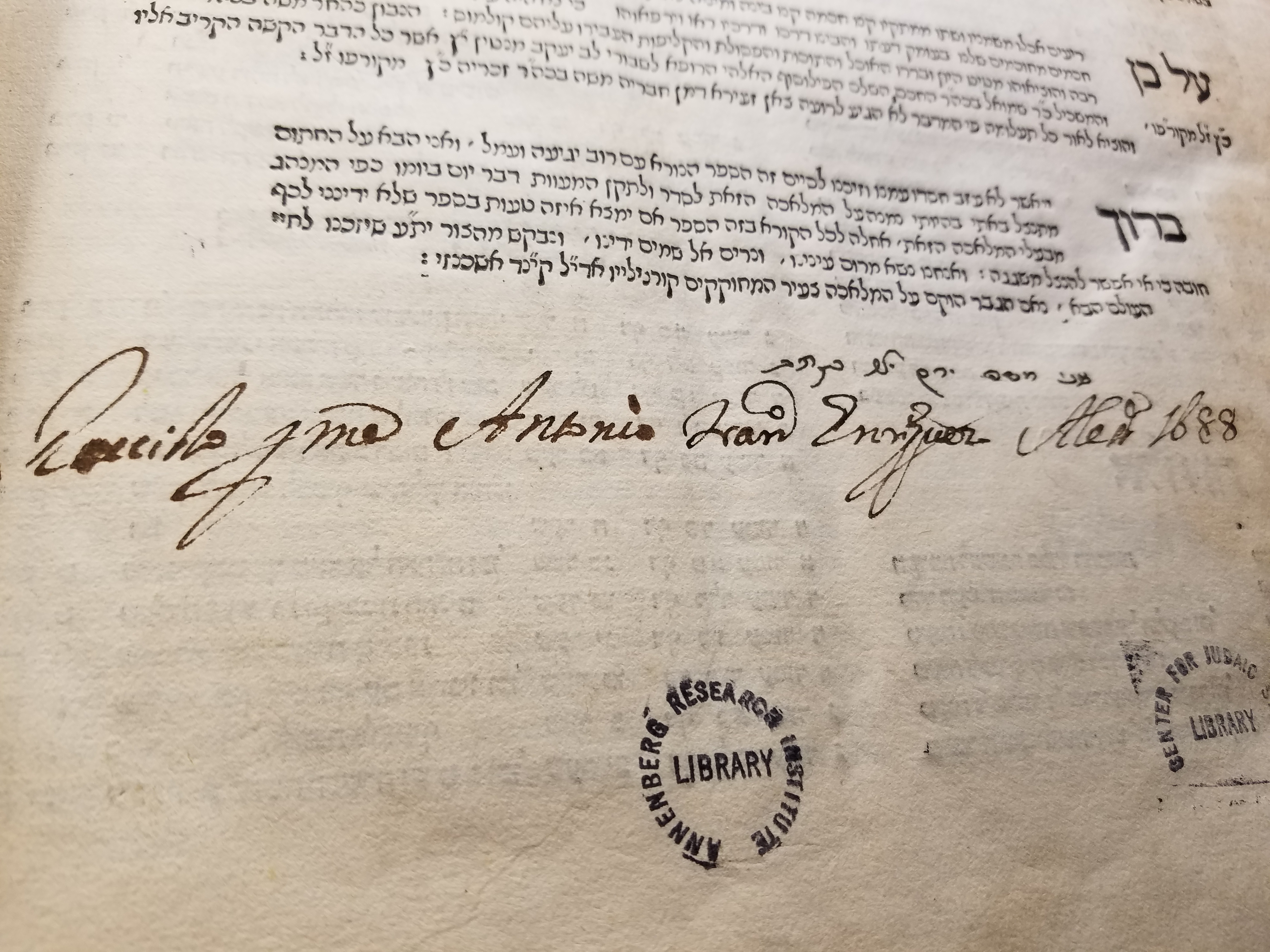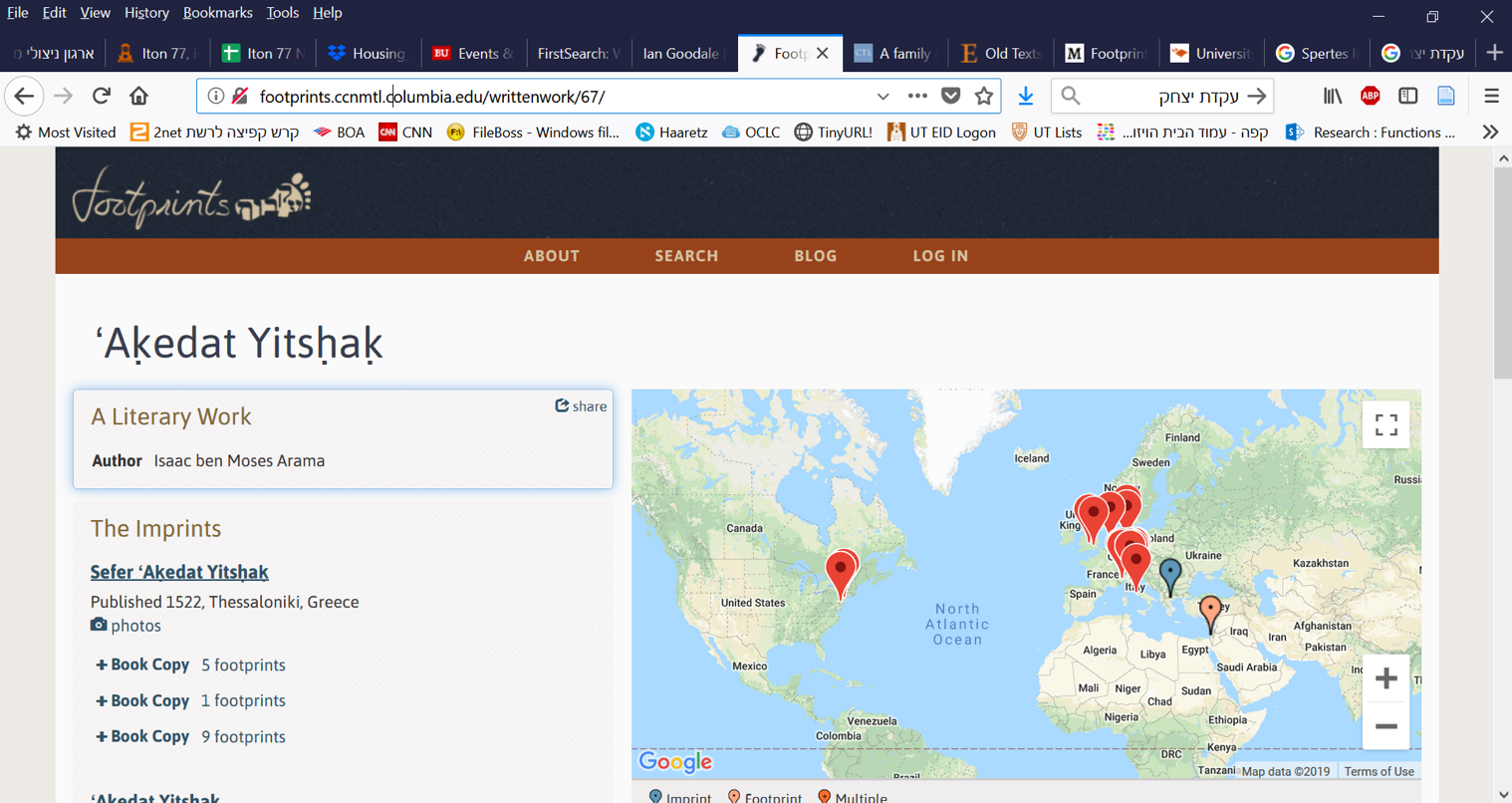Read, hot & digitized: Librarians and the digital scholarship they love — In this series, librarians from UTL’s Arts, Humanities and Global Studies Engagement Team briefly present, explore and critique existing examples of digital scholarship.
Working as a book conservator back in the days in Tel Aviv, I was always intrigued by the notes and scribbles found on flyleaves, covers, and pages of centuries-old books. It seemed that this text, which supposedly was not related to the actual content of the book in hand, had its own story to tell – about places, people, and events. Now this data is playing the main role in Footprints; these pieces of information could be interlinked, and show us a new spatial landscape of Jewish texts through generations.
The goal of the project, a collaborative initiative by the Jewish Theological Seminary, Columbia University, University of Pittsburgh, and Stony Brook University, is to create a “database to track the circulation of printed ‘Jewish books’ (in Hebrew, other Jewish languages, and books in Latin and non-Jewish vernaculars with Judaica contents).”[1] Those notes, scribbles, and ‘marginal’ pieces of information are scattered in many forms. Footprints lists many types of evidence while documenting the movement of books, and presents visualizations of mobility, including mapping. Some types of evidence include owners’ signatures and bookplates; handwritten notations of sales; estate inventories; references to exchanges of books in correspondence of scholars or merchants; unpublished booklists copied in flyleaves; printers’ colophons; subscription lists, and lists of approbations indicating backers or patrons of the books who presumably received a copy of the product.[2]
Take for example the literary work titled ʻAḳedat Yitsḥaḳ (“the Binding of Isaac”) – a collection of philosophical homilies and commentaries on the Torah by Isaac ben Moses Arama (1420-1494).
This text is represented by five different imprints. Each imprint is represented by various unique copies, and each copy has between one to nine ‘footprints.’ For example, the imprint published in 1547 in Venice, Italy, has five unique ‘holdings’ in the database. One of these copies is traced through six different ‘time stamps’, owners, and locations, from 1599 (Modena, Italy) through 1986 (New York, NY). Another fascinating example is the journey of a copy of Masekhet Nedarim (a Talmudic tractate) printed in Venice in 1523. In 1663 it was bought (and sold) in Yemen. Between 1842 to 1894 it was owned by Alexander Kohut in New York, and since 1915 this particular copy has been owned by Yale University, New Haven, CT.

Librarians and researches from Europe, Israel, and Unites States are constantly adding new information and validating accuracy of current entries. The database currently includes 7638 unique footprints, and is searchable by keywords, footprint year, and publication year. Here in Austin, The Harry Ransom Center is also collaborating with Footprints; data gleaned from the Center’s early Hebrew books holdings, mainly those dated pre-1800, will be uploaded soon to the database.
Footprints is an open-source and open-access tool; it uses a PostgresSQL, an object-relational database system, which is available on Github. As such, it is both a digital humanities project and a global collaborative project. The digital platform makes public the very process of scholarship performed by trusted crowd sourcing. The collaborative platform invites immediate feedback, editing, and revision.[3] The project owners anticipate future uses to include inferential statistical analysis and network visualization. They anticipate that “cultural historians and statisticians would leverage their mutual areas of expertise to offer a statistical analysis that takes into account social, cultural, political, and economic contexts.”[4] In addition, they plan to visualize networks of book movement showing connections between places, and networks connecting individuals to each other or to other places.
Footprints brings to mind Bakhtin’s Chronotope, where time and place are merging into one meaningful experience. A physical printed book travels through times and places; created, owned, and used by various individuals, carrying with it ideas and intellectual meaning. A Chronotope of the Jewish book, Footprints is a multidimensional bibliography, which highlights and makes use of previously unknown resources in a way that re-imagines the practice of Jewish book history.
Further reading (all available at Perry-Castañeda Library)
Pearson, David. 2007. “What Can We Learn by Tracking Multiple Copies of Books?” In Books on the Move : Tracking Copies through Collections and the Book Trade, edited by Robin Myers, Michael Harris and Giles Mandelbrote, 17-37. New Castle: Oak Knoll Press ; London : British Library.
Walsby, Malcolm and Natasha Constantinidu, eds. 2013. Documenting the Early Modern Book World: Inventories and Catalogs in Manuscript and Print. Leiden: Brill.
Dweck, Yaacob. 2010. “What is a Jewish Book?” Association for Jewish Studies Review 34: 367-376.
[1] http://footprints.ccnmtl.columbia.edu/about/
[2] http://footprints.ccnmtl.columbia.edu/about/#about02
[3] Michelle Chesner, Marjorie Lehman, Adam Shear, Joshua Teplitsky. “Footprints: Tracking Individual Copies of Printed books Using Digital Methods.” 2018. Medaon, 23. https://www.medaon.de/en/artikel/footprints-tracking-individual-copies-of-printed-books-using-digital-methods/
[4] http://footprints.ccnmtl.columbia.edu/about/#about05


